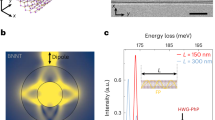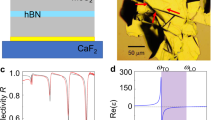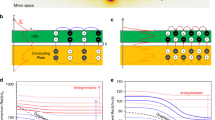Abstract
Compressing light into nanocavities substantially enhances light–matter interactions, which has been a major driver for nanostructured materials research. However, extreme confinement generally comes at the cost of absorption and low resonator quality factors. Here we suggest an alternative optical multimodal confinement mechanism, unlocking the potential of hyperbolic phonon polaritons in isotopically pure hexagonal boron nitride. We produce deep-subwavelength cavities and demonstrate several orders of magnitude improvement in confinement, with estimated Purcell factors exceeding 108 and quality factors in the 50–480 range, values approaching the intrinsic quality factor of hexagonal boron nitride polaritons. Intriguingly, the quality factors we obtain exceed the maximum predicted by impedance-mismatch considerations, indicating that confinement is boosted by higher-order modes. We expect that our multimodal approach to nanoscale polariton manipulation will have far-reaching implications for ultrastrong light–matter interactions, mid-infrared nonlinear optics and nanoscale sensors.
This is a preview of subscription content, access via your institution
Access options
Access Nature and 54 other Nature Portfolio journals
Get Nature+, our best-value online-access subscription
$29.99 / 30 days
cancel any time
Subscribe to this journal
Receive 12 print issues and online access
$259.00 per year
only $21.58 per issue
Buy this article
- Purchase on Springer Link
- Instant access to full article PDF
Prices may be subject to local taxes which are calculated during checkout




Similar content being viewed by others
Data availability
The data that support the findings of this study are available from the corresponding author upon request.
References
Baumberg, J. J. et al. Extreme nanophotonics from ultrathin metallic gaps. Nat. Mater. 18, 668–678 (2019).
Chikkaraddy, R. et al. Single-molecule strong coupling at room temperature in plasmonic nanocavities. Nature 535, 127–130 (2016).
Benz, F. et al. Single-molecule optomechanics in ‘picocavities’. Science 354, 726–729 (2016).
Leng, H. et al. Strong coupling and induced transparency at room temperature with single quantum dots and gap plasmons. Nat. Commun. 9, 4012 (2018).
Yoo, D. et al. Ultrastrong plasmon–phonon coupling via epsilon-near-zero nanocavities. Nat. Photon. 15, 125–130 (2021).
Mueller, N. S. et al. Deep strong light-matter coupling in plasmonic nanoparticle crystals. Nature 583, 780–784 (2020).
Ciuti, C., Bastard, G. & Carusotto, I. Quantum vacuum properties of the intersubband cavity polariton field. Phys. Rev. B 72, 115303 (2005).
Frisk Kockum, A. et al. Ultrastrong coupling between light and matter. Nat. Rev. Phys. 1, 19–40 (2019).
Andolina, G. M., Pellegrino, F. M. D., Giovannetti, V., MacDonald, A. H. & Polini, M. Theory of photon condensation in a spatially varying electromagnetic field. Phys. Rev. B 102, 125137 (2020).
Schäfer, C., Flick, J., Ronca, E., Narang, P. & Rubio, A. Shining light on the microscopic resonant mechanism responsible for cavity-mediated chemical reactivity. Nat. Commun. 13, 7817 (2022).
Schuller, J. et al. Plasmonics for extreme light concentration and manipulation. Nat. Mater. 9, 193–204 (2010).
Ashida, Y., İmamoǧlu, A. & Demler, E. Cavity quantum electrodynamics with hyperbolic van der Waals materials. Phys. Rev. Lett. 130, 216901 (2023).
Flick, J., Ruggenthaler, M., Appel, H. & Rubio, A. Atoms and molecules in cavities, from weak to strong coupling in quantum-electrodynamics (QED) chemistry. Proc. Natl Acad. Sci. USA 114, 3026–3034 (2017).
Garcia-Vidal, F. J., Ciuti, C. & Ebbesen, T. W. Manipulating matter by strong coupling to vacuum fields. Science 373, eabd0336 (2021).
Santhosh, K. et al. Vacuum Rabi splitting in a plasmonic cavity at the single quantum emitter limit. Nat. Commun. 7, ncomms11823 (2016).
Kuttge, M., García De Abajo, F. J. & Polman, A. Ultrasmall mode volume plasmonic nanodisk resonators. Nano Lett. 10, 1537–1541 (2010).
Epstein, I. et al. Far-field excitation of single graphene plasmon cavities with ultracompressed mode volumes. Science 368, 1219–1223 (2020).
Brar, V. W. et al. Highly confined tunable mid-infrared plasmonics in graphene nanoresonators. Nano Lett. 13, 2541–2547 (2013).
Nikitin, A. et al. Real-space mapping of tailored sheet and edge plasmons in graphene nanoresonators. Nat. Photon. 10, 239–243 (2016).
Wang, S. et al. Metallic carbon nanotube nanocavities as ultracompact and low-loss Fabry-Pérot plasmonic resonators. Nano Lett. 20, 2695–2702 (2020).
Mock, J. J. et al. Shape effects in plasmon resonance of individual colloidal silver nanoparticles. J. Chem. Phys. 116, 6755–6759 (2002).
Kelly, K. L. et al. The optical properties of metal nanoparticles: the influence of size, shape, and dielectric environment. J. Phys. Chem. B 107, 668–677 (2003).
Yang, X. et al. Experimental realization of three-dimensional indefinite cavities at the nanoscale with anomalous scaling laws. Nat. Photon. 6, 450–454 (2012).
Indukuri, S. C. et al. Ultrasmall mode volume hyperbolic nanocavities for enhanced light–matter interaction at the nanoscale. ACS Nano 13, 11770–11780 (2019).
Dubrovkin, A. M. et al. Resonant nanostructures for highly confined and ultra-sensitive surface phonon-polaritons. Nat. Commun. 11, 1863 (2020).
Wang, T. et al. Optical properties of single infrared resonant circular microcavities for surface phonon polaritons. Nano Lett. 13, 5051–5055 (2013).
Alfaro-Mozaz, F. et al. Nanoimaging of resonating hyperbolic polaritons in linear boron nitride antennas. Nat. Commun. 8, 15624 (2017).
Giles, A. J. et al. Imaging of anomalous internal reflections of hyperbolic phonon-polaritons in hexagonal boron nitride. Nano Lett. 16, 3858–3865 (2016).
Ambrosio, A. et al. Mechanical detection and imaging of hyperbolic phonon polaritons in hexagonal boron nitride. ACS Nano 11, 8741–8746 (2017).
Tamagnone, M. et al. Ultra-confined mid-infrared resonant phonon polaritons in van der Waals nanostructures. Sci. Adv. 4, eaat7189 (2018).
Tamagnone, M. et al. High quality factor polariton resonators using van der Waals materials. Preprint at https://arxiv.org/abs/1905.02177 (2019).
Autore, M. et al. Boron nitride nanoresonators for phonon-enhanced molecular vibrational spectroscopy at the strong coupling limit. Light Sci. Appl. 7, 17172 (2018).
Caldwell, J. et al. Sub-diffraction, volume-confined polaritons in the natural hyperbolic material, hexagonal boron nitride. Nat. Commun. 5, 5221 (2014).
Brown, L. V. et al. Nanoscale mapping and spectroscopy of nonradiative hyperbolic modes in hexagonal boron nitride nanostructures. Nano Lett. 18, 1628–1636 (2018).
Autore, M., Dolado, I. & Li, P. Enhanced light–matter interaction in 10B monoisotopic boron nitride infrared nanoresonators. Adv. Opt. Mater. 9, 2001958 (2021).
Yang, J. et al. Ultrasmall metal-insulator-metal nanoresonators: impact of slow-wave effects on the quality factor. Opt. Express 20, 16880–16891 (2012).
Chatzakis, I. et al. Strong confinement of optical fields using localized surface phonon polaritons in cubic boron nitride. Opt. Lett. 43, 2177–2180 (2018).
Lee, I. H. et al. Image polaritons in boron nitride for extreme polariton confinement with low losses. Nat. Commun. 11, 3649 (2020).
Giles, A. et al. Ultralow-loss polaritons in isotopically pure boron nitride. Nat. Mater. 17, 134–139 (2018).
Guo, X. et al. Hyperbolic whispering-gallery phonon polaritons in boron nitride nanotubes. Nat. Nanotechnol. 18, 529–534 (2023).
Duan, J. et al. Active and passive tuning of ultranarrow resonances in polaritonic nanoantennas. Adv. Mater. 34, 2104954 (2022).
Low, T. et al. Polaritons in layered two-dimensional materials. Nat. Mater. 16, 182–194 (2017).
Ocelic, N., Huber, A. & Hillenbrand, R. Pseudoheterodyne detection for background-free near-field spectroscopy. Appl. Phys. Lett. 89, 101124 (2006).
Hillenbrand, R. et al. Coherent imaging of nanoscale plasmon patterns with a carbon nanotube optical probe. Appl. Phys. Lett. 83, 368–370 (2003).
Li, P. et al. Hyperbolic phonon-polaritons in boron nitride for near-field optical imaging and focusing. Nat. Commun. 6, 7507 (2015).
Dai, S. et al. Subdiffractional focusing and guiding of polaritonic rays in a natural hyperbolic material. Nat. Commun. 6, 6963 (2015).
Li, N. et al. Direct observation of highly confined phonon polaritons in suspended monolayer hexagonal boron nitride. Nat. Mater. 20, 43–48 (2020).
Torre, I., Orsini, L., Ceccanti, M., Herzig Sheinfux, H. & Koppens, F. H. L. Green’s functions theory of nanophotonic cavities with hyperbolic materials. Preprint at https://arxiv.org/abs/2104.00511 (2021).
Herzig Sheinfux, H. et al. Evolution and reflection of ray-like excitations in hyperbolic dispersion media. Preprint at https://arxiv.org/abs/2104.00091 (2021).
Acknowledgements
F.H.L.K. acknowledges support from the ERC TOPONANOP under grant agreement no. 726001, the ERC proof-of-concept grant Polarsense, the Government of Spain (FIS2016-81044; Severo Ochoa CEX2019-000910-S), Fundació Cellex, Fundació Mir-Puig and Generalitat de Catalunya (CERCA, AGAUR, SGR 1656). Furthermore, the research leading to these results has received funding from the European Union’s Horizon 2020 programme under grant agreement no. 881603 (Graphene Flagship Core3). H.H.S. acknowledges funding from the European Union’s Horizon 2020 programme under the Marie Skłodowska-Curie grant agreement no. 843830. N.C.H.H. acknowledges funding from the European Union’s Horizon 2020 programme under the Marie Skłodowska-Curie grant agreement no. 665884. R.B. acknowledges funding from the European Union’s Horizon 2020 research and innovation programme under the Marie Skłodowska-Curie grant agreement no. 847517. L.O. acknowledges support by The Secretaria d'Universitats i Recerca del Departament d'Empresa i Coneixement de la Generalitat de Catalunya, as well as the European Social Fund (L'FSE inverteix en el teu futur)—FEDER. M.C. acknowledge the support of the 'Presencia de la Agencia Estatal de Investigación' within the Convocatoria de tramitación anticipada, correspondente al año 2020, de las ayudas para contractos predoctorales (Ref. PRE2020-094864) para la formación de doctores contemplada en el Subprograma Estatal de Fromación del Programa Estatal de Promoción del Talento y su Empleabilidad en I+D+i, en el marco del Plan Estatal de Investigacón Científica y Técnica de Innovación 2017–2020, cofinanciado por el Fondo Social Europeo. J.H.E. acknowledges support from the Office of Naval Research (award N00014-20-1-2474). M.J. and G.S. acknowledge support from the Office of Naval Research (ONR) under grant no. N00014-21-1-2056, the support of the Army Research Office under award W911NF2110180 and by the National Science Foundation (NSF) under grant no. DMR-1719875. M.J. was also supported in part by the Kwanjeong Fellowship from Kwanjeong Educational Foundation. R.M. and V.P. acknowledge support from the Opto group Plan Nacional project (TUNASURF). We also wish to thank J. Osmond, H. Lozano and N. V. Hulst for help with the FIB operation, which was also supported by the European Commission under ERC Advanced Grant 670949-LightNet.
Author information
Authors and Affiliations
Contributions
H.H.S., L.O., M.C., D.B.R., S.C., R.M. and V.P. worked on the sample fabrication with help from A.Hötger. and A.Holleitner. The isotopic hBN crystals were grown by E.J. and J.H.E. The measurements were performed by H.H.S. and L.O. with help from D.B.R. and N.C.H.H. The analytical and semi-analytical theory was developed by H.H.S., I.T. and M.C., and the numerical calculations were performed by M.J., M.C., S.M., R.B. and G.S. The experiments were designed by H.H.S. and F.H.L.K. All authors contributed to writing the manuscript and A.Holleitner., V.P., G.S. and F.H.L.K. supervised the work.
Corresponding author
Ethics declarations
Competing interests
The authors declare no competing interests.
Peer review
Peer review information
Nature Materials thanks the anonymous reviewers for their contribution to the peer review of this work.
Additional information
Publisher’s note Springer Nature remains neutral with regard to jurisdictional claims in published maps and institutional affiliations.
Supplementary information
Supplementary Information
Supplementary Sections 1–5, Figs. 1–31 and references.
Supplementary Video 1
Simulated electric-field amplitude in an inverted cavity, for plane-wave excitation at a varying frequency (Supplementary Section 4.2). The cavity is expected to be resonant at around 1,393 cm–1, but shows no clear resonant response. The simulation dimensions are scaled for presentation purposes, the size of the MEC (inverted cavity) is 260 nm and the flake is 10 nm thin. The brighter areas in the colour map correspond to a higher signal and each subplot is separately normalized.
Supplementary Video 2
Simulated electric-field phase in an inverted cavity, for plane-wave excitation at a varying frequency (Supplementary Section 4.2). The simulation dimensions are scaled for presentation purposes, the size of the MEC (inverted cavity) is 260 nm and the flake is 10 nm thin. The colour map goes from –π (green) to π (purple).
Supplementary Video 3
Simulated electric-field amplitude in an MEC cavity, for plane-wave excitation at a varying frequency (Supplementary Section 4.2). As the frequency reaches the resonant frequency of 1,507 cm–1, the field is strongly localized inside the cavity and exhibits sharp (multimodal) ray-like features. The simulation dimensions are scaled for presentation purposes, the size of the MEC (inverted cavity) is 260 nm and the flake is 10 nm thin. The brighter areas in the colour map correspond to a higher signal and each subplot is separately normalized.
Supplementary Video 4
Simulated electric-field phase in an MEC cavity, for plane-wave excitation at a varying frequency (Supplementary Section 4.2). The simulation dimensions are scaled for presentation purposes, the size of the MEC (inverted cavity) is 260 nm and the flake is 10 nm thin. The colour map goes from –π (green) to π (purple).
Supplementary Video 5
Simulated intensity profile of a multimodal nanoray propagating inside an hBN flake (edges indicated by cyan lines) when it is incident on a single metallic corner. The ray is excited by a dipole situated outside (to the left), which is not shown to avoid colour saturation. The frequency of excitation—and therefore the angle of the nanoray—is swept throughout the video. When the ray is exactly incident on the corner, it experiences strong (enhanced) reflection, whereas for other frequencies, the ray experiences enhanced transmission (Supplementary Section 4.3).
Rights and permissions
Springer Nature or its licensor (e.g. a society or other partner) holds exclusive rights to this article under a publishing agreement with the author(s) or other rightsholder(s); author self-archiving of the accepted manuscript version of this article is solely governed by the terms of such publishing agreement and applicable law.
About this article
Cite this article
Herzig Sheinfux, H., Orsini, L., Jung, M. et al. High-quality nanocavities through multimodal confinement of hyperbolic polaritons in hexagonal boron nitride. Nat. Mater. 23, 499–505 (2024). https://doi.org/10.1038/s41563-023-01785-w
Received:
Accepted:
Published:
Issue Date:
DOI: https://doi.org/10.1038/s41563-023-01785-w
This article is cited by
-
Direct programming of confined surface phonon polariton resonators with the plasmonic phase-change material In3SbTe2
Nature Communications (2024)



